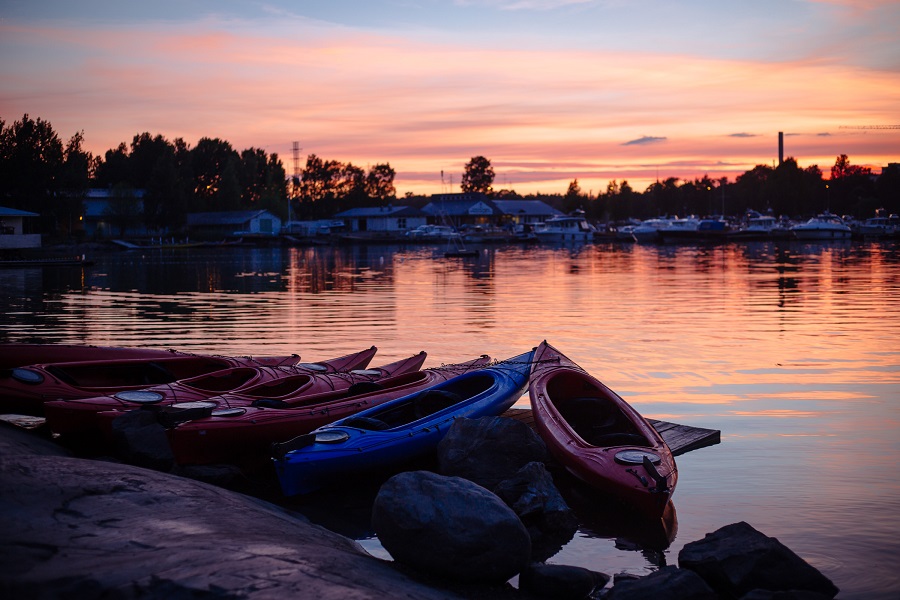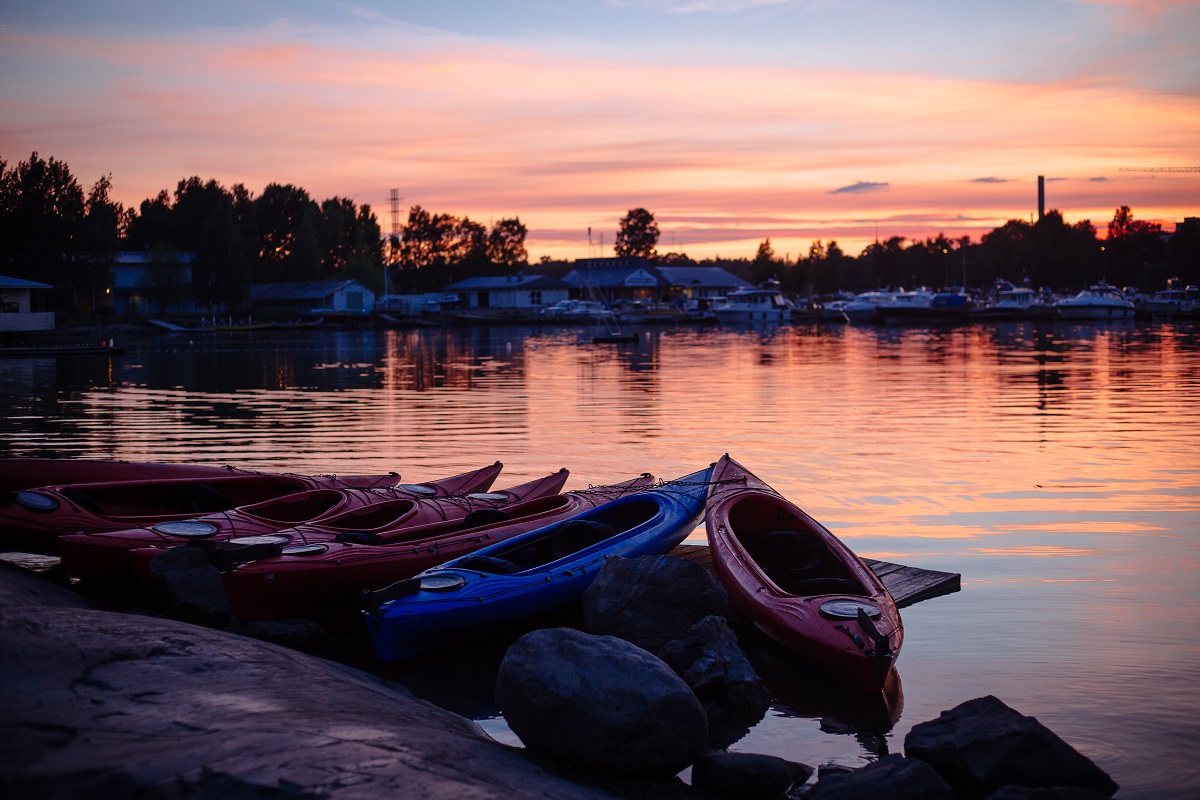Kayaking, why should it be on your to-do list? I would say, it is is one of the best ways to experience nature and it is very friendly to beginners. In this post, I would like to introduce Catherine from Gear Expert Guides, who is a kayaking enthusiast.
My blog is primarily about Finland, and if you come in summer, I highly recommend kayaking. You can do it at one of the thousands of lakes, as well as at archipelago in Espoo or in Turku. In the very end of the post, I will provide some basic information about kayaking in Finland.
Now Cathrine will tell you the basics about types of kayaking, about boat types and kayaking gear.
Is Kayaking on Your To-Do List? Here’s What You Need to Know
They say water is life and you really can’t argue with that. Kayaking presents the most intimate and enjoyable way to feel and enjoy the waters of our land, other than swimming. Apart from kayaking safety gear, here’s what else you need.

Kayaking is one of those outdoor activities that are not only fun and exciting to engage in, but also teach you essential life skills like control, endurance, and navigation. What’s more, learning how to row a kayak is easier than learning to ride a bike and would make for some great Instagram pics too if you’re into that sort of thing. If you are a beginner, here are some important points we thought you should know about kayaking:
Types of Kayaking

There are several types of kayaking that you can engage in, depending on your environment. The 3 main types include:
- Sea Kayaking – Involves paddling a kayak in large, open water bodies such as oceans, lakes, and bays. Sea kayaks have covered decks and are relatively longer (between 10 and 25 feet) to facilitate storage of gear and food and most importantly, make it easy to paddle in straight lines.
- Recreational Kayaking – This is typically kayaking casually for fun on a shallow lake, pool or a flatwater stream. Recreational kayaks are usually quite smaller in length (less than 12 feet on average) and have larger cockpits to enable easy entry and exits. They are also relatively light and very easy to handle.
- Whitewater Kayaking – Basically paddling kayaks through moving water bodies that also have rapids, such as rivers and creeks. Whitewater kayaks are shorter compared to sea kayaks but stronger and more stable.
Other types of kayaking that exist but are not as popular include kayak camping and kayak fishing. In summary, knowing the type of kayaking available in your area guides you on the best kayaks to buy/hire and the gear.
Start with Some Lessons
Forget what we said about kayaking being easy to learn, you’ll most likely struggle without advanced help. We strongly advise getting some kayaking lessons, whether from kayaking centers or from a friend who’s a pro. If they’re skilled (and willing) enough, they will furnish you with some essential kayaking tips for beginners such as how to paddle faster and more effectively to avoid going around in circles. Understanding proper form in regards to holding paddles as well as different types of strokes will also help you conserve energy and efficiency.
It will also be great to learn how to recover from a capsize as it is always a possibility when you hit the waters. Depending on your location and nature of instructors, you can get detailed lessons and learn some kayaking techniques for beginners for as little as $10 per hour.
Get the Right Gear
Kayaking is a mentally and physically engaging activity, and you need to have the right accessories and the best fishing kayak to not only keep warm and comfortable but also make it easier to escape if you capsize. Top of the list is a fitting Personal Floatation Device (PFD) and, of course, a paddle that goes with your hand size. Other kayaking equipment to carry include a bilge pump, sun-shielding hat, neoprene footwear, and non-cotton waterproof kayak pants and top.
Essential Kayaking Safety Gear
Related to the above point is the need to bring along a bunch of items to sustain and safeguard your life in case anything unprecedented happens while you are in the waters. Here are some examples of kayaking gear:
- A dry bag or two to keep your things dry
- A first aid kit to help keep things in control during emergencies
- A waterproof watch
- Some snacks and water to keep you energized
- A sound signaling device such as a whistle in case you’re stranded
- An inflatable PFD approved by your local or national coastguard
- Some polarized sunglasses to protect your eyes from the elements as well as enable you to spot things around you
- Water shoes
- A buoyant heaving line
- Flashlight
Notably, the kayaking safety gear to carry depends on the size and nature of your kayak boat, the type of water body you plan to kayak in as well as your local laws. However, the above kayak accessories are the most commonly used all over the world and are available in most kayaks outlets.
Choose Your Boat Wisely
There are lots of options available if you want to go kayaking, depending on what type of water body you’re going to as well as your objectives. Options range from flatwater boats to narrow racing boats and on to small playboats better suited for small pools. For beginners, we recommend sit-on-top wooden kayaks as they offer more stability and are much easier to paddle. It’s also good to get a kayak that allows you to make adjustments in the angle of the seatback and footpegs to allow for comfortable paddling.
Tandem Kayaking is Fun Too!

If you are not sure of your paddling skills, or you just want to have some extra fun with a friend or spouse, you may want to try some tandem kayaking. For the uninitiated, this is where two people get on the same boat, usually bigger than the usual one-person kayak boats, and try to paddle together. Here, paddling in sync is very much the key as apart from avoiding a clash of paddles, it helps move the boat much faster. However, it is not a must for the two paddlers to paddle at the same time, which makes tandems a great teaching tool.
Basically, the stronger, more experienced paddler sits at the back while the rookie sits in front. That way, the latter can dictate paddling pace while the former is in a better position to observe their rookie’s mistakes and correct them.
Conclusion
Whatever your reason for kayaking, you want to have a fun and memorable experience whether with your friends, family or by yourself. Indeed, kayaking challenges you both mentally and physically and triggers the release of adrenaline which is the perfect high for some of us. Just follow our advice and recommendations, and you’ll enjoy your time in the water. Also, feel free to comment with other additional tips for beginners or any questions you may have.
About the author: Catherine Wiley is a blogger who obsessed with writing about kayaking and traveling. Her travel reviews will help readers enhance their experience in outdoor activities. Currently, Catherine is working as a content editor at gearexpertguides.com.
Kayaking in Finland, the basics
Northern cities look fantastic from water, whether it is Helsinki, Copenhagen, Vancouver or Seattle. But Finland is even more, it is known as the land of thousands of lakes. It is also the land of thousands of small islands all along the seashore. In summer, Finnish waters are full of life, with kayaking, being one of the most popular tourist activities. You can even do it in the city center.

Most of the rental models are sit-inside touring kayaks. However, some places rent more advanced sea kayaks, including tandem options. The price varies, popular touristic places would charge 20-40 Euros for 2 hours (depending on the kayak model). Smaller kayak stations charge around 50 Euros for a day.
On lakes, rent usually includes a dry-bag, PFD (life jacket), basic instruction and, if needed, a waterproof map. Gear-wise, for calm lake waters, nothing else is required. For archipelago, rental options vary quite heavy and you may also be restricted to a certain area.
Join my community!
I love working on Engineer on tour, but it is a time-consuming thing to make. I am always improving and trying to bring you the best from photography and travel.
Currently, my main platform is my Facebook Photo Page. I will be happy to see you among my followers’ families and engage in a friendly discussion. Let me know how I’m doing and feel free to suggest some topics to write about.
You can also find me on other social media:
FACEBOOK 2 (blog updates only) / TWITTER / INSTAGRAM / INSTAGRAM 2 (only Finland) / PINTEREST


